Fast breaks
Two Side (Rocket)
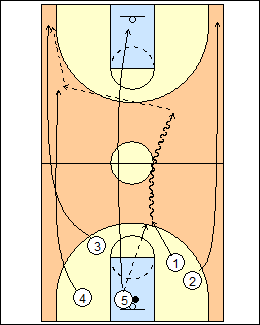
| 1 The two-side fast break was made popular by teams such as the Houston Rockets and Auburn Tigers. Basics:
- two players get wide early and sprint to the corners
- another player gets wide and sprints to a 45-degree angle, creating a "two side"
- the ballhandler pushes the ball, looking for a pass to the two side or the single side (the pass can be early or late)
- the two side can be weakside (preferably) or ballside
- a skip pass to the two side creates a long closeout or a 2-on-1 situation, which can be exploited with a "one-more" pass, for example (shown)
- 5 inbounds (or rebounds and outlets) then rim runs late for 4-out spacing, or stops at the top of the key for 5-out spacing - any other rebounder who outlets looks to fill out top
- the stretched 4-out spacing basically creates two double gaps for the ballhandler. Brent Tipton - 2 Side Transition - 1 loops to the nail to receive an outlet (stampedes the catch by already moving downhill, chest to halfcourt) - early and opposite - a hit ahead opposite the outlet early in the possession (e.g. from the backcourt) moves transition defence twice - early and up - a hit ahead up the same sideline as the outlet (then look to skip opposite to the two side) - they want "3, key, free" in the first 6-8 seconds of the shot clock, i.e. an uncontested 3, rim or paint finish, or a foul in transition. See YouTube playlist - Two-Side (Rocket) break. |
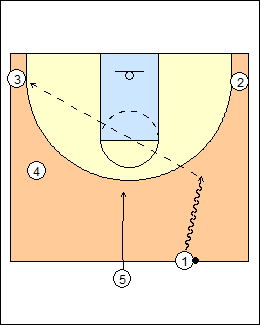
| 2 Here 5 trails to above the top of the key, for 5-out spacing.
Tipton - the inbounder / rebounder always becomes the trail and fills the centre top spot. The stretched spacing between 4 and 3 means that one defender can't guard two. Joshua Longstaff - 5-out spacing, the inbounder / rebounder fills the trail spot. The closest player inbounds on a made basket. See Fast breaks - NBA 5-out. - a rebounder outlets then spaces to 45 opposite (here that would be 4), 5 fills the middle (or rim runs), - 5 inbounds, trails, and can rim run late. Alex Sarama - Conceptual Offence - the closest player inbounds, grab the ball out of the net, make a deep outlet (past the foul line). On a miss, whoever rebounds is the point guard, with no outlet. No traditional rim run (unless behind the last defender), space and create a two side on the weakside, the ball is being dribbled up the other side with a strongside corner. If they get the ball anywhere on the two side it's dominoes. The last player can go to the weakside dunker if ahead of the ball, or just trail and maybe make a three side (join the two side) if behind the ball. Tyler Lindsey - 5-out Drive and Space - 1 and 5 fill both slots, preferably with 1 on the single side. In 5-out, also square the top on a pass back out of a corner. |
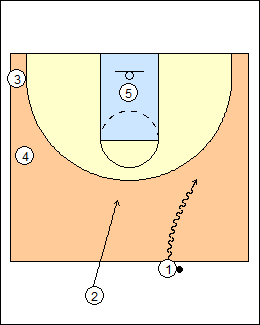
| 3 It's possible to have a two side but not a single side.
Here 5 rim runs, and 2 trails out top (e.g. after a rebound and outlet, or there is already a two side). (Variations) - 2 runs the right sideline opposite the two side for a delayed single side (especially if 5 fills out top), e.g. see Tipton 2 Side Transition at 2:24 - if 3 runs up the right sideline, 2 could push 4 to the left corner, see below. Oliver - How to Run the Two Side Fast Break - two side concept - two players run to the weakside corner and 45, the ballhandler dribble pushes and looks to pass to the two side, use a 2-on-1 advantage. Here 1 can pass to 4 or 3, the pass can be early or late (shown). Post 5 rim runs early or late, the remaining player fills the middle. Rocket Break - with the two-side fast break, 3 doesn't have to relocate (change sides) for floor balance. |
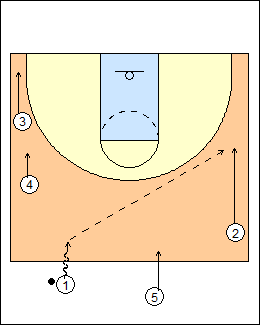
| 4 Here the two side is ballside, and an opposite hit ahead goes to the single side.
John Leonzo (see below) - you sometimes get a "3 side", that's OK. Longstaff - if there are 3 players on the same side of the floor, the first player runs the baseline to the other corner.
|
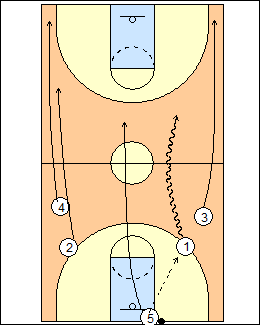
| 5 John Leonzo - 5-out Transition Offence
Find an easy way to play fast after makes and misses.
They have pre-set spots on a make - 3 right corner, 4 left corner, 2 left wing, 1 right wing, 5 trails.
5 inbounds (is almost always around the rim and can inbound faster), then trails for 5-out spacing, keeping the paint open for the point guard.
1 gets an outlet (inbounds pass) on the right every time. Because 5 trails, they like 1 to push the ball up the middle then work out.
A skip pass creates a long closeout or a 2-in-1, or 1 drives if defenders stay at home on shooters. Trailer 5 dives on a drive and kick.
A pass to trailer 5 triggers pre-set action to get into dribble-drive motion, e.g. pick and roll, or dribble handoff and dive. |
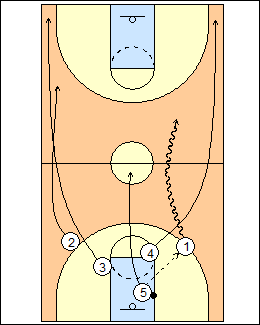
| 6 On a defensive rebound, 1 and 2 are both point guards ("pushers"), they get to outlet spots on each side of the floor, above the foul-line extended, with 1 on the right side (or they could be interchangeable). An outlet pass below the foul line is a turnover in practice.
Whichever pusher gets the outlet pass (or rebound) pushes the ball, the other pusher becomes the top player on the two side (or trails to the top of the key if there is already a two side).
Tipton - "become your own outlet" - rebound and dribble push.
3 and 4 are interchangeable "runners", they sprint the nearest sideline to the corner (wide first, deep second), and can both be on the same side. 3 and 4 have freedom because 1 and 2 have discipline on their sidelines.
If a pusher keeps going deep to a corner, a runner can take the top of the two side.
5 reads whether to rim run or trail (e.g. if behind the ball). |
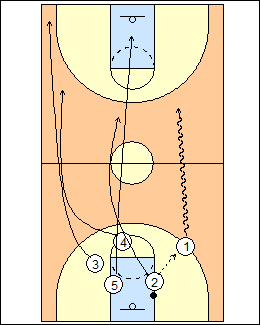
| 7 Since 3 and 4 find the nearest sideline on a miss, they can be on the same side.
Here pusher 2 gets a rebound and outlets to 1, 5 rim runs, runners 4 and 3 go up the same sideline, 2 reads that 3 is in his spot and fills the top of the key, instead of being the top of the two side. There is no single side.
It would be the same if 1 rebounds and pushes the ball while 2 trails on the play. (If 5 rebounds, outlets to 1 and 2 fills the top of the key, the open spot for 5 would be a late rim run.) |

| 8 If a runner gets a rebound and outlets to a pusher, they stay behind the ball, just become a trailer.
Here runner 4 rebounds and outlets to 1, 5 rim runs, 3 and 2 run up the same side, 4 starts to run the nearest sideline then trails to the top of the key since there is a two side. There is no single side. |
|
|